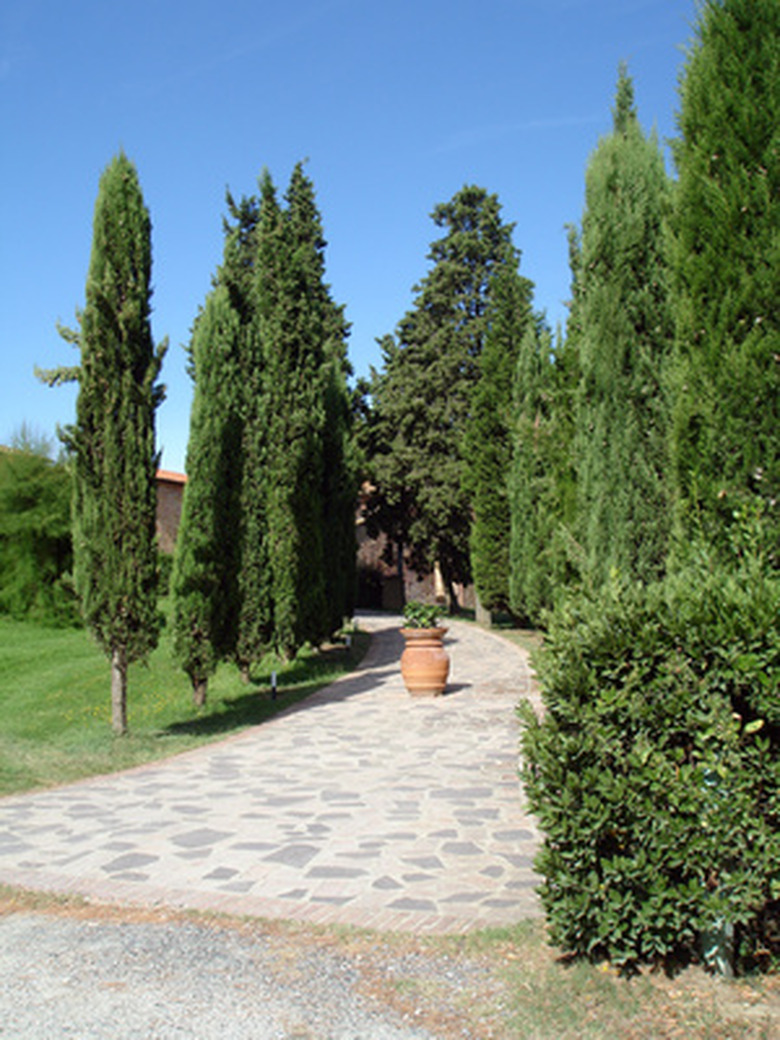Fertilizer For An Italian Cypress
Italian cypress are ornamental conifers. They are evergreen and have a very narrow columned habit. The tree can reach 70 feet tall in a sunny, well-drained location. They are a slim pyramid shape with gray-green scale-type leaves that are more like needles when young. Italian Cypress originated in southern Europe and Asia, but are now extremely popular in many other areas. The trees need minimal care, but will need supplemental watering once or twice a month and can thrive with a seasonal application of a balanced fertilizer.
History
Italian cypress are commonly known as Mediterranean cypress, graveyard or funeral cypress. As the latter two names indicate, the trees grace cemeteries In Southern Europe. It is thought the Romans began cultivation of this tree as an ornamental and that the oil from the tree was a prized aromatic. The trees can tolerate almost any soil and need full sun to thrive. The branches sweep upward and the tree is generally a spire pointing at the sky. Italian cypress are not susceptible to many pests, but can get scale and mites during hot dry weather.
- Italian cypress are ornamental conifers.
- The trees need minimal care, but will need supplemental watering once or twice a month and can thrive with a seasonal application of a balanced fertilizer.
Fertilizing
New plants should be fertilized to give them help with root growth. Phosphorus promotes healthy roots and it is the second number in a fertilizer ratio. The ratio is NPK, which indicate nitrogen, phosphorus and potassium, all key minerals for plant growth. Apply fertilizer at the time of planting and water in well to prevent roots from burning. After the tree is established it is sufficient to fertilize every two to three years at the end of winter, just before growth begins again.
Organic fertilizers
As a substitute to purchased fertilizers, the tree will benefit from an organic fertilizer. Steer or chicken manure can be worked into the soil around the base of the tree. Take care not to pile the amended soil around the base of the trunk, as it stifles it and can contribute to rotting. Also, Earthworm humus or castings can be worked into soil. These are rich in nutrients and decompose rapidly to release their benefits into the soil. Compost tea is another way to fertilize. The tea can be added to the monthly watering so it gets soaked deep into the earth and roots of the trees.
- New plants should be fertilized to give them help with root growth.
- The tea can be added to the monthly watering so it gets soaked deep into the earth and roots of the trees.
Mulching
Organic gardeners know the value of mulching. Mulch will conserve moisture and add beneficial nutrients back into soil. Mulch also serves to keep down weeds and other plants under trees that might compete for nutrition and water. The mulch will break down and provide organic matter to the soil, enhancing soil texture, providing a home for beneficial bacteria, improving water filtration and promoting root growth. Mulches are a natural alternative to fertilizers. Mulches can be grass clippings, straw, bark chips or other compostable organic material.
Warning
The worst thing to do to an Italian cypress is overwater it. Naturally, young unestablished trees need extra water until their root systems spread out and take hold. However, the Italian cypress comes from an area where there is only about 20 inches of rain per year. Any more than that and foliage may turn brown or rusty and the plant will begin to die. To prevent this you should amend the soil before planting to increase drainage with sand or another textured addition. Preventative care is always the best strategy on any plant.
- Organic gardeners know the value of mulching.
- Mulch also serves to keep down weeds and other plants under trees that might compete for nutrition and water.
